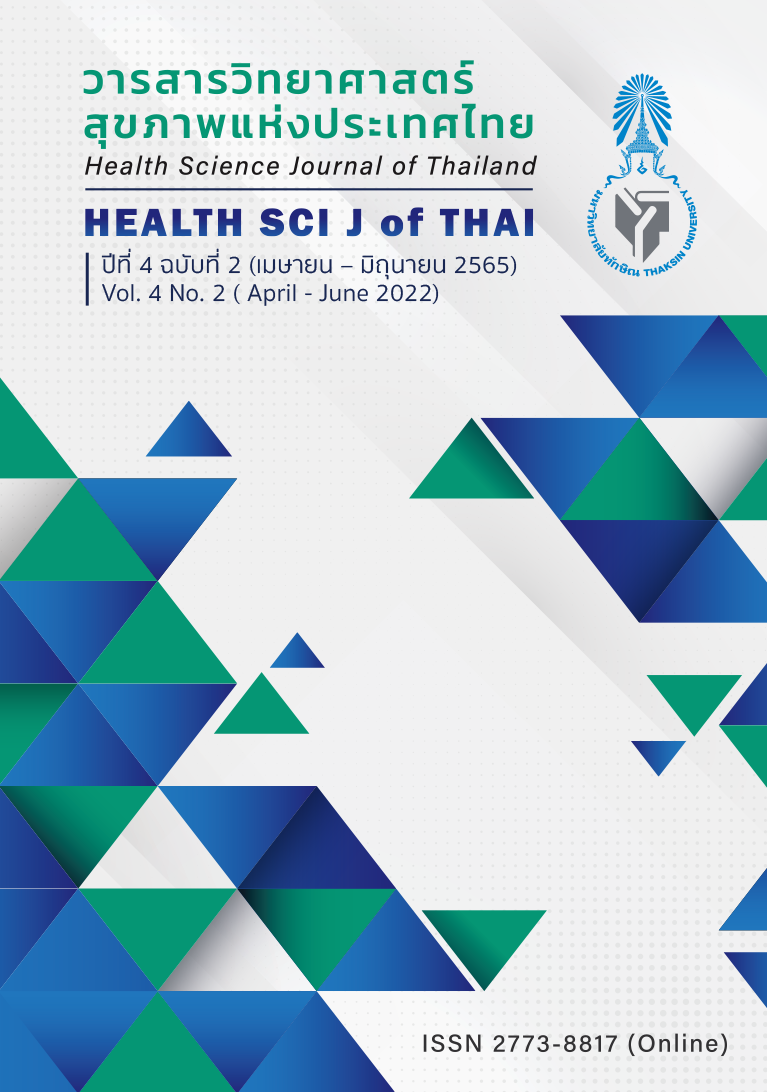Pharmaceutical Services on Severe Migraine Headache in Community Pharmacies
Main Article Content
Abstract
Severe migraine attacks often required treatment with specific drugs. The study of pharmaceutical services on the patients with migraine headache has still been limited in Thailand. This study aimed to investigate the pharmaceutical services offered for a severe migraine patient in the community pharmacies. The study was descriptive research and collected data by using a simulated patient with a severe migraine headache. The fifty-seven community pharmacies, in Phayao province, Thailand, were assessed for the pharmaceutical services. The results demonstrated that the simulated patients received the services from 33 pharmacist-pharmacies (57.89%) and 24 non-pharmacist pharmacies (42.11%). The most frequent dispensed medication was the single drug of pain relievers (n = 30, 52.63%). Non-steroidal anti-inflammatory drug (n = 14, 24.56%), ergotamine (n = 8, 14.04%), and paracetamol (n = 8, 14.04%) were top three most dispensed pain relievers, respectively. Combination therapy between analgesics and other medications was found in 13 pharmacies (22.81%). Domperidone was used as an antinausea drug (n = 8, 14.04%). Prophylactic drugs (n = 6, 10.53%) were flunarizine (n = 35.26%), cinnarizine (n = 2, 3.51%), and amitriptyline (n=1, 1.75%). In conclusion, most pharmacy personnel performed inappropriate practice on taking the necessary information from the patient and drug dispensing for severe migraine. Educational interventions should be developed and trained to improve knowledge and practice in the migraine management.
Article Details

This work is licensed under a Creative Commons Attribution-NonCommercial-NoDerivatives 4.0 International License.
References
Maneemai O, Jaipinta T and Rattanatanyapat P. Evaluation of community pharmacy personnel in pharmaceutical services using the
simulated patient. Thai Bull Pharm Sci 2020; 15(2): 47–57. (In Thai)
Saengcharoen W, Lerkiatbundit S. Migraine management in community pharmacies: practice patterns and knowledge of pharmacy personnel in Thailand. Headache 2013; 53(9): 1451–1463.
Saengcharoen W, Lerkiatbundit S. Practice and attitudes regarding the management of childhood diarrhoea among pharmacies in Thailand. Int J Pharm Pract 2010; 18(6): 323–331.
Lu SR, Wang SJ, Fuh JL. The practice pattern of migraine management among neurologists in Taiwan. Cephalalgia 2006; 26(3): 310–313.
Lipton RB, Bigal ME, Rush SR, Yenkosky JP, Liberman JN, Bartleson JD, et al. Migraine practice patterns among neurologists. Neurology 2004; 62(11): 1926–1931.
Gallagher RM, Kunkel R. Migraine medication attributes important for patient compliance: Concerns about side effects may delay treatment. Headache 2003; 43(1): 36–43.
Kristoffersen ES, Lundqvist C. Medicationoveruse headache: Epidemiology, diagnosis and treatment. Ther Adv Drug Saf 2014; 5(2): 87–99.
Schreiber CP, Hutchinson S, Webster CJ, Ames M, Richardson MS, Powers C. Prevalence of migraine in patients with a history of self-reported or physiciandiagnosed “sinus” headache. Arch Intern Med 2004; 164(16): 1769–1772.
Saengcharoen W, Chongsuvivatwong V, Lerkiatbundit S, Wongpoowarak P. Client and pharmacist factors affecting practice in the management of upper respiratory tract infection presented in community pharmacies: a simulated client study. Int J Pharm Pract 2010; 16(4): 265–270.
Santos AP, Mesquita AR, Oliveira KS, Lyra Jr DP. Assessment of community pharmacists´ counselling skills on headache management by using the simulated patient approach: a pilot study. Pharm Pract 2013; 11(1): 3–7.
Rutter PM, Horsley E, Brown DT. Evaluation of community pharmacists' recommendations to standardized patient scenarios. Ann Pharmacother 2004; 38(6): 1080–1085.
Netere AK, Erku DA, Sendekie AK, Gebreyohannes EA, Muluneh NY, Belachew SA. Assessment of community pharmacy professionals’ knowledge and counseling skills achievement towards headache management: a cross-sectional and simulated-client based mixed study. J
Headache Pain 2018; 19(1): 96.
Silberstein SD, Education T. Practice parameter: evidence-based guidelines for migraine headache (an evidence-based review): report of the Quality Standards Subcommittee of the American Academy of Neurology. Neurology 2000; 55(6): 754–762.
Marmura MJ, Silberstein SD, Schwedt TJ. The acute treatment of migraine in adults: the American Headache Society evidence assessment of migraine pharmacotherapies. Headache 2015; 55(1): 3–20.
Lohman JJ, van der Kuy-de Ree MM; Group of Co-operating Pharmaciststs Sittard-Geleen and its environs. Patterns of specific antimigraine drug use - a study based on the records of 18 community pharmacies. Cephalalgia 2005; 25(3): 214–218.
Smitherman TA, Burch R, Sheikh H, Loder E. The prevalence, impact, and treatment of migraine and severe headaches in the United States: a review of statistics from national surveillance studies. Headache 2013; 53(3): 427–436.
Truter I, Louwrens B, Kotze TJW. Dispensing patterns of antimigraine agents with a focus on seasonal variations in prescribing. Trop J Pharm Res 2018; 17(7): 1439–1444.
American Headache Society. The American Headache Society position statement on integrating new migraine treatments into clinical practice. Headache 2019; 59(1): 1–18.
Antonaci F, Dumitrache C, De Cillis I, Allena M. A review of current European treatment guidelines for migraine. J Headache Pain 2010; 11(1): 13–19.
Latinovic R, Gulliford M, Ridsdale L. Headache and migraine in primary care: consultation, prescription, and referral rates in a large population. J Neurol Neurosurg Psychiatry 2006; 77(3): 385–387.


